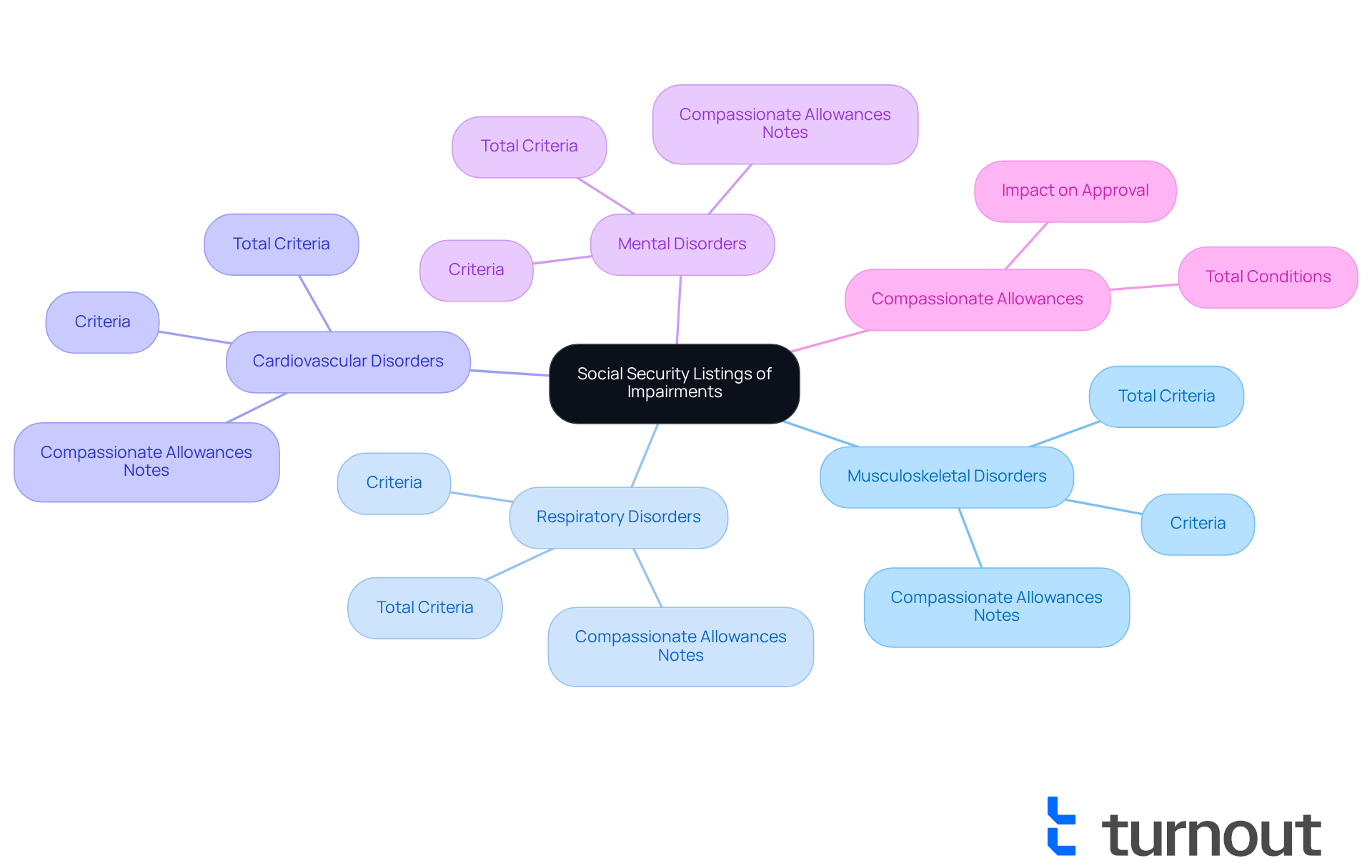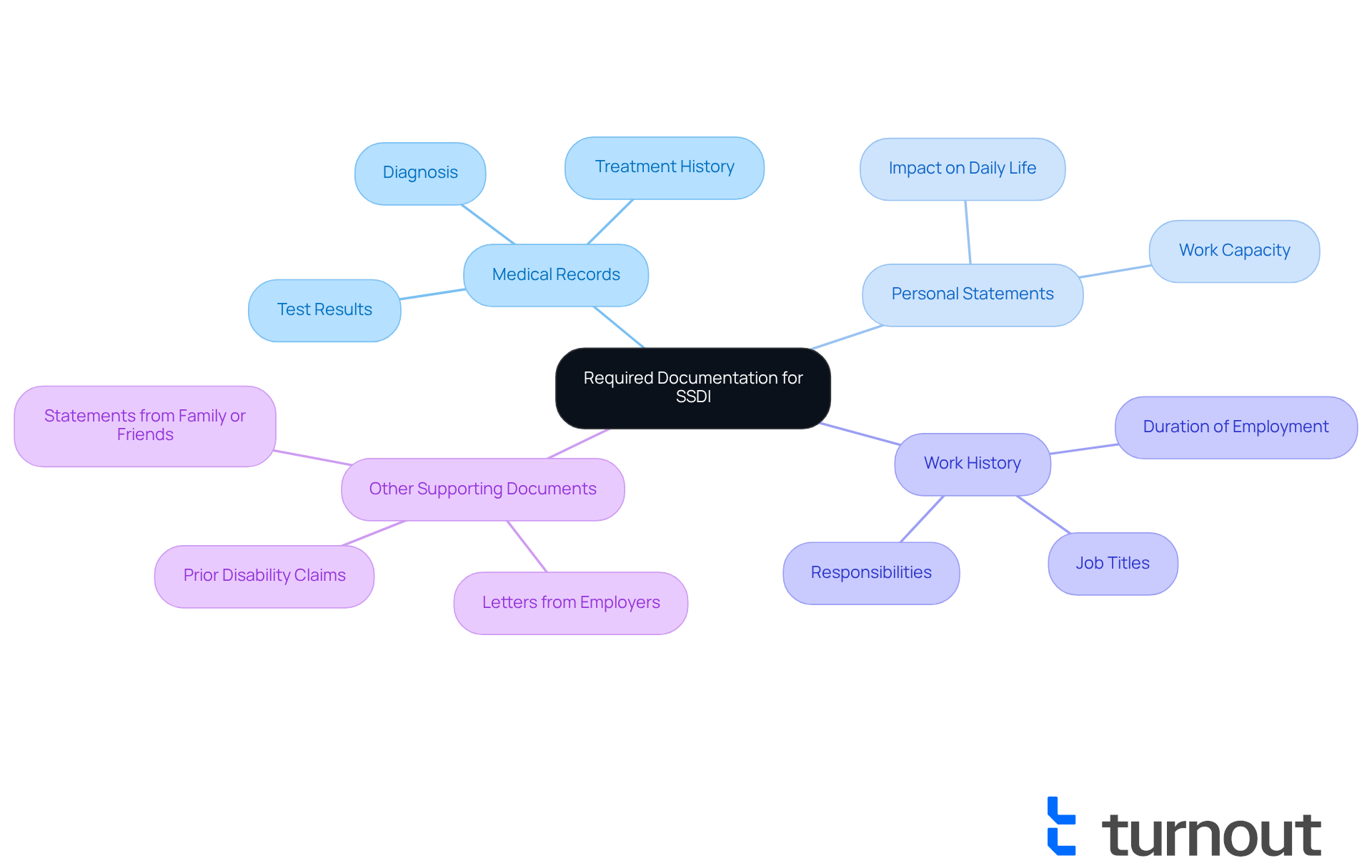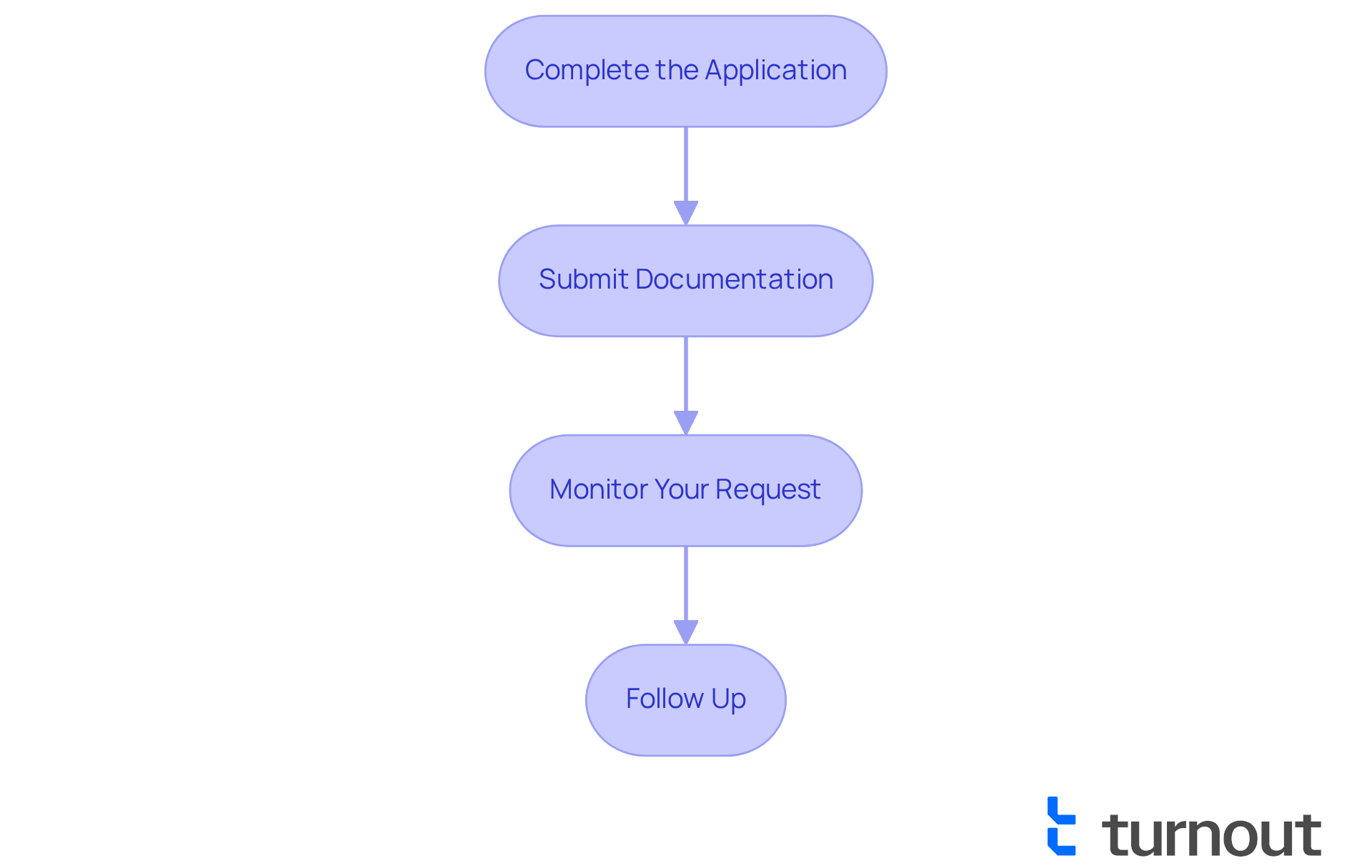Overview
This article addresses the important journey of mastering the Social Security Listings of Impairments, particularly for those facing significant medical challenges. We understand that navigating this complex process can feel overwhelming. It’s essential to grasp the detailed criteria outlined in the 'Blue Book,' as this knowledge can significantly impact your path to securing benefits.
Gathering comprehensive medical documentation is a crucial step in this journey. By ensuring your application is well-supported, you enhance the likelihood of approval for Social Security Disability benefits. Remember, you are not alone in this process; many have successfully navigated these waters, and with the right guidance, you can too.
We encourage you to follow a structured application process. Taking it step by step can make the experience feel more manageable. As you embark on this journey, know that we’re here to help you every step of the way.
Introduction
Understanding the intricacies of the Social Security Listings of Impairments, often referred to as the 'Blue Book,' is crucial for individuals facing significant health challenges. This comprehensive guide outlines the specific medical conditions that qualify for benefits and reflects the evolving landscape of disability criteria. With 2025 bringing notable updates and new compassionate allowances, it’s common to feel overwhelmed by the changes.
As you navigate this complex system, you may wonder:
- How can you effectively demonstrate your eligibility?
- How can you ensure your claims are approved amidst stringent requirements and evolving standards?
You're not alone in this journey, and we’re here to help you find the answers you need.
Understand the Social Security Listings of Impairments
The , often lovingly referred to as the 'Blue Book,' serves as an important resource for individuals facing significant medical challenges. It outlines specific medical issues that are deemed serious enough by the (SSA), as detailed in the social security listings of impairments, to hinder an individual from engaging in substantial gainful activity. This comprehensive guide is thoughtfully organized by major body systems, such as musculoskeletal, respiratory, cardiovascular, and mental disorders. Each listing provides detailed criteria that applicants must meet to qualify for benefits.
As we look ahead to 2025, will include a total of 300 criteria, reflecting the SSA's commitment to addressing a wide variety of disabilities. Notably, 13 new requirements have been added to the , which expedites the process for individuals grappling with serious illnesses. This compassionate initiative has already assisted over 1.1 million individuals in receiving quicker approvals for disability benefits.
Understanding the social security listings of impairments is vital for anyone . If you are dealing with challenges like chronic depression or PTSD, you may find that the clearer definitions and less subjective criteria in the . Advocates emphasize the importance of to support your claims, especially since the SSA conducts periodic medical reviews every 3 to 7 years to ensure ongoing eligibility.
The significance of the Blue Book cannot be overstated; it acts as an essential guide for applicants to determine if their circumstances align with the social security listings of impairments. By familiarizing yourself with the social security listings of impairments, you can better assess your eligibility and thoughtfully prepare your applications. and does not provide legal representation, offers valuable tools and services to assist clients in navigating the complexities of SSD claims effectively. For more detailed information, the full listings are accessible on the SSA's official website, providing essential insights into each impairment category. Remember, you are not alone in this journey; we are here to help.

Identify Eligible Medical Conditions
If you're facing a medical issue and wondering if it qualifies for , we understand how overwhelming this process can be. A good starting point is to examine the provided by the SSA. Here are some common conditions that may be eligible:
- : This category includes conditions like arthritis, back pain, and joint dysfunction. These issues are often prevalent among SSDI applicants, as musculoskeletal disorders are frequently referenced in disability claims.
- Respiratory Disorders: Conditions such as (COPD) and asthma require specific evidence of severity and duration to qualify.
- Cardiovascular Disorders: Heart disease and fall into this category, with strict criteria regarding their impact on daily functioning.
- Mental Disorders: This includes various disorders such as depression, anxiety disorders, and schizophrenia, each with specific eligibility criteria.
Each of these conditions has specific criteria that must be met, including the severity and duration of symptoms. It's essential to consult the social security listings of impairments to confirm if your situation is included and to understand the detailed requirements for each impairment. Recent updates have broadened the list of qualifying criteria, including new entries that reflect the evolving understanding of . For example, the addition of certain cancers and rare disorders aims to expedite the approval process for those facing .
Real-life stories show that individuals with qualifying musculoskeletal disorders have successfully navigated this process, often with the help of that simplify documentation and increase the chances of approval. Remember, you're not alone in this journey—we're here to help you every step of the way.
. Each branch represents a main category, and the sub-branches list specific conditions under that category. Follow the branches to see what issues might help in your disability claims.](https://images.tely.ai/telyai/xljzjybs-this-mindmap-shows-different-categories-of-medical-conditions-that-may-qualify-for-social-security-benefits-each-branch-represents-a-main-category-and-the-sub-branches-list-specific-conditions-under-that-category-follow-the-branches-to-see-what-issues-might-help-in-your-disability-claims.webp)
Gather Required Documentation and Evidence
When applying for , we understand that can feel overwhelming. It’s essential to support your claim effectively. Here’s what you need:
- : Obtain detailed records from your healthcare providers, including your diagnosis, treatment history, and relevant test results. In 2025, the typical SSDI request contains numerous health records, highlighting the necessity for thorough documentation.
- : Write a personal statement describing how your situation impacts your daily life and capacity to work. This story can greatly improve your application by offering important context to your health records.
- : Provide a detailed work history, including job titles, responsibilities, and the duration of employment. This information helps establish your work capacity prior to your disability.
- Other Supporting Documents: Include records of any prior disability claims, letters from employers, and statements from family or friends concerning your situation. These documents can provide additional insights into your circumstances.
Ensure that all documents are up to date and accurately represent your health condition. To establish the severity of your impairment, the Social Security Administration (SSA) requires from acceptable sources as outlined in the . Remember, the clarity and structure of your medical records can significantly affect the outcome of your submission. It’s essential to provide a , and we’re here to help you through this process. You are not alone in this journey.

Navigate the Application Process and Follow-Up
Navigating the application process for can feel overwhelming, but you don't have to face it alone. Here are some :
- Complete the Application: You can apply online through the SSA website, by phone, or in person at your local SSA office. As of 2025, online submissions are becoming more popular, allowing you to save your progress and return later if needed. It's crucial to complete all sections accurately to avoid delays, as incomplete submissions are a common cause of processing holdups.
- Submit Documentation: Along with your request, please submit all gathered documentation and evidence to support your claim. This includes medical records, work history, and any other relevant information. Missing necessary documents can significantly postpone your request, so double-check that everything is included.
- Monitor Your Request: After submission, keep through your my Social Security account or by contacting the SSA directly. You can check your status online or call the SSA at 1-800-772-1213, where automated assistance is available 24/7. We understand that waiting can be stressful, but staying informed helps ease anxiety.
- Follow Up: If you do not receive a decision within the expected timeframe, please to inquire about your status. Advocates emphasize the importance of this step, as proactive follow-ups can lead to quicker resolutions. Be ready to provide your submission details for reference, as this will assist the SSA in locating your file more efficiently.
By staying proactive and organized throughout the , you can help ensure that your claim is processed smoothly and efficiently. through trained nonlawyer advocates who can assist you in navigating this process, ensuring you have the guidance needed to enhance your chances of success. It’s important to note that Turnout is not a law firm and does not provide legal advice. Additionally, Turnout also provides assistance with , further supporting clients in navigating complex financial systems. Real-life examples show that individuals who consistently follow up on their claims often experience faster processing times and improved outcomes. Understanding that the Social Security Administration is currently understaffed and underfunded can help you appreciate the importance of being diligent in your follow-ups. Remember, you are not alone in this journey; we’re here to help.

Conclusion
Understanding the Social Security Listings of Impairments is crucial for individuals seeking disability benefits. This comprehensive framework, often referred to as the 'Blue Book,' outlines the specific medical conditions that can hinder your ability to work, providing a structured approach to assessing eligibility. By familiarizing yourself with these listings, you can better align your circumstances with the requirements set forth by the Social Security Administration (SSA).
We understand that navigating this process can feel overwhelming. Key insights include:
- The significance of the 2025 updates to the Blue Book, which will introduce new criteria and Compassionate Allowances aimed at expediting the approval process for those facing severe health challenges.
- Gathering thorough documentation, such as medical records and personal statements, is vital in substantiating your claims.
- It's common to feel uncertain, but following up on submissions diligently can ensure timely processing and increase your chances of success.
Ultimately, the path to securing Social Security benefits can be complex and daunting. However, understanding the listings and being proactive in your application process can significantly enhance your prospects. For anyone grappling with severe medical conditions, utilizing available resources and seeking assistance can make a meaningful difference. Remember, you are not alone in this journey. With the right knowledge and support, achieving a successful outcome is within reach.
Frequently Asked Questions
What is the purpose of the Social Security Listings of Impairments, also known as the 'Blue Book'?
The Blue Book serves as a resource for individuals facing significant medical challenges, outlining specific medical issues that are serious enough to hinder an individual from engaging in substantial gainful activity.
How is the Blue Book organized?
The Blue Book is organized by major body systems, including musculoskeletal, respiratory, cardiovascular, and mental disorders. Each listing provides detailed criteria that applicants must meet to qualify for benefits.
How many criteria will the Blue Book include by 2025?
By 2025, the Blue Book will include a total of 300 criteria, reflecting the SSA's commitment to addressing a wide variety of disabilities.
What are Compassionate Allowances (CAL)?
Compassionate Allowances are new requirements added to the listings that expedite the process for individuals with serious illnesses, helping them receive quicker approvals for disability benefits.
How many individuals have been assisted by the Compassionate Allowances initiative?
The Compassionate Allowances initiative has already assisted over 1.1 million individuals in receiving quicker approvals for disability benefits.
Why is understanding the social security listings of impairments important for SSDI applicants?
Understanding the listings is vital for navigating the SSDI application process, as clearer definitions and less subjective criteria can enhance the chances of approval for individuals dealing with challenges like chronic depression or PTSD.
What should applicants do to support their claims for benefits?
Applicants should gather comprehensive medical evidence to support their claims, as the SSA conducts periodic medical reviews every 3 to 7 years to ensure ongoing eligibility.
Where can individuals find the full listings of impairments?
The full listings are accessible on the SSA's official website, providing essential insights into each impairment category.
What resources does Turnout offer to assist clients with SSD claims?
Turnout offers valuable tools and services to help clients navigate the complexities of SSD claims effectively, although it does not provide legal representation.




